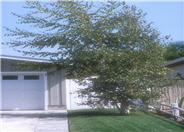
Common name:European White Birch
Botanical name:Betula pendula
This medium-size weeping tree will grow to about 40' tall and has a whitish-brown bark with deciduous green leaves.

Common name:Razzleberry Red Fringe Flower
Botanical name:Loropetalum chinense 'Razzleberri'
Red Fringe Flower is a 6'-12' shrub with arching branches and reddish leaves .

Common name:Lamb's Ear
Botanical name:Stachys byzantina
This tiny shrub will grow less than 1' tall and has medium-size, greyish-green leaves with blue and lavender flowers that bloom in the spring. This shrub is grown more for its velvety leaves than the flowers. It is drought tolerant once it's established. Be careful not to overwater.

Common name:Dwarf Heavenly Bamboo
Botanical name:Nandina domestica 'Nana Compacta'
The ' Nana Compacta' is a small, rounded shrub that grows from 12"-15" high. Its growth habit is dense, and the leaves become bright red in color in cold, winter areas. It can receive sun to part shade, and is used well as an accent plant.

Common name:Wheeler's Dwarf Pittosporum
Botanical name:Pittosporum tobira 'Wheeler's Dwarf'
This handsome dwarf form of the Pittosporum tobira grows into a low, dense mound, 2'-3' tall and 4'-5' wide. This shrub is covered with glossy, evergreen foliage. Small, fragrant, white flowers cover this shrub in spring. It prefers full to part sun and is drought tolerant once its established. Give extra water in summer. Wheeler's Dwarf is dependable and easy to grow. Prune in winter to keep shape.

Common name:Lily of the Nile
Botanical name:Agapanthus praecox ssp. orientalis
This evergreen shrub will grow about 3' tall and has large green leaves with blue flowers that bloom in spring and summer. It will grow in all soils but prefers loam soil. It can be grown in sun or shade. Lily of the Nile prefers a moderate amount of water; established plants have low water use.
Healthy soil is the cornerstone of a vibrant landscape. It provides oxygen and nutrients vital to plant growth and sustenance. It provides protection from the sun and stability for root systems.
Click in the green box for more information
Designer:
Photographer: GardenSoft
Incorporate compost 6" into your soil to retain water, reduce compaction, feed earthworms, and provide valuable nutrients to your plants.
Remove irrigation water and fertilizer from areas where you don't want weeds to grow.